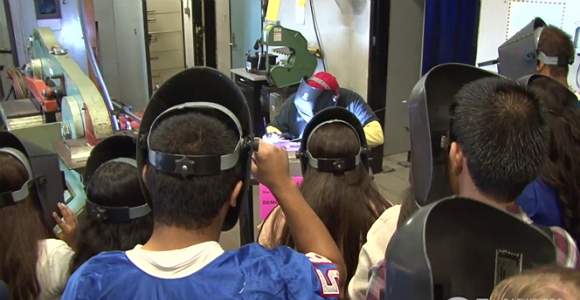
(Photo Credit: John Guenther/CA Fwd)
The California Community Colleges have released and are updating robust data on how $200 million in Career Technical Education (CTE) funding is going to be spent across California.
“Getting this information online and available to the public is an important part of the work,” said Dr. Matthew Roberts, dean of field operations for the Workforce and Economic Development Division for the California Community College Chancellor’s Office. “We urge employers, civic and business leaders and the colleges to follow the progress the colleges are making as the regional and local projects get underway.”
The data are divided into two main sections: $113 million that will be spent at local colleges and the $72 million for regional plans, those which involve more than one community college working together. This new ongoing funding is structured as a 60 percent Local Share allocation for each community college district and a 40 percent Regional Share determined by a regional consortia of colleges to focus on the state’s seven macro-economic regions.
Already, 542 local share proposals totaling over $87 million have been approved.
One hundred and twenty regional proposals have been certified at the cost of the $46.6 million. The largest of those is a Global Trade and Logistics Regional Consortia and Digital Badging, being led by Los Angeles Southwest College. The consortia now involves 10 colleges in Southern California.
“We’re actively exploring how to develop certificate programs that are of value to the employers in this sector,” said Rick Hodge dean of CTE at L.A. Southwest College. “In addition, there’s a great emphasis on job placement to make sure that qualified students who are interested in this sector can land a job.”
Global Trade and the movement of goods is a huge driver in the California economy. The Inland Empire has seen a 21 percent job growth in the last six years, second only to the San Francisco Bay Area—driven by the state’s warehousing sector, which has increased 26 percent in that time.
For more on the types of jobs California is creating, read this in-depth story by Anthony York of the Grizzly Bear Project.
The story focuses on California’s economic and regional diversity, which is also at the heart of the Strong Workforce Program the Colleges have launched.
“The diversity of California's economy demands different skills for different regions,” said Van Ton-Quinlivan, vice chancellor for Workforce and Economic Development for the Community College system. “When the Legislature invested an additional $200 million in career technical education, we designed a process to address those regional needs.”
The critical need for one million more skilled workers is why CA Fwd and the California Economic Summit have worked so hard to support the Strong Workforce Program of the California Community Colleges.
“The California Economic Summit has been promoting expanded workforce training for the past five years. It is a huge issue in California and we've worked closely with the Chancellor's office to help develop and promote this work,” said Leah Grassini Moehle, CA Fwd program manager for workforce development. “The Strong Workforce Program embraces data, collaboration, and innovation to rejuvenate the way California thinks about the workforce. It's a major step forward for the state.”
It's leaders like Chancellor Eloy Ortiz Oakley and Vice Chancellor Ton-Quinlivan who have positioned California Community Colleges as a national leader in workforce preparation.
“The California Community Colleges are taking the lead on career technical education nationally to ensure that we’re creating programs and curricula that allow students to quickly get into the workforce and take advantage of the jobs that are out there,” said Oakley.
By publishing the data online, it allows all the stakeholders to view what the colleges are doing and how.
“Transparency is an important part of this process,” added Ton-Quinlivan. “California employers and employees now can see that the money being spent in the various regions address the employment needs of that region.”

